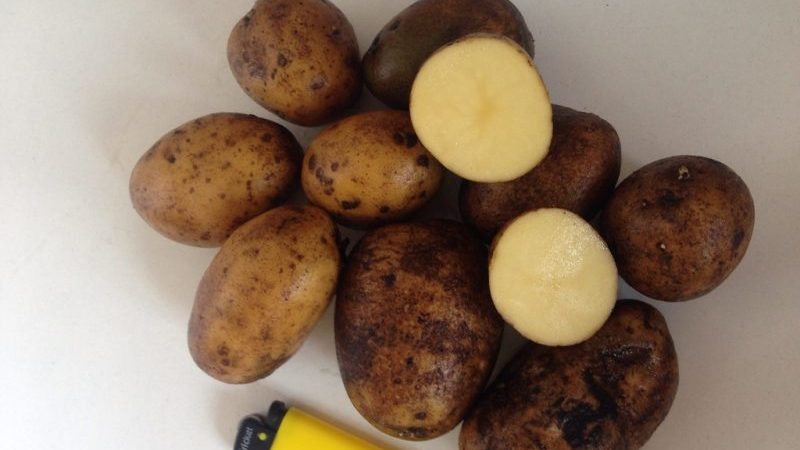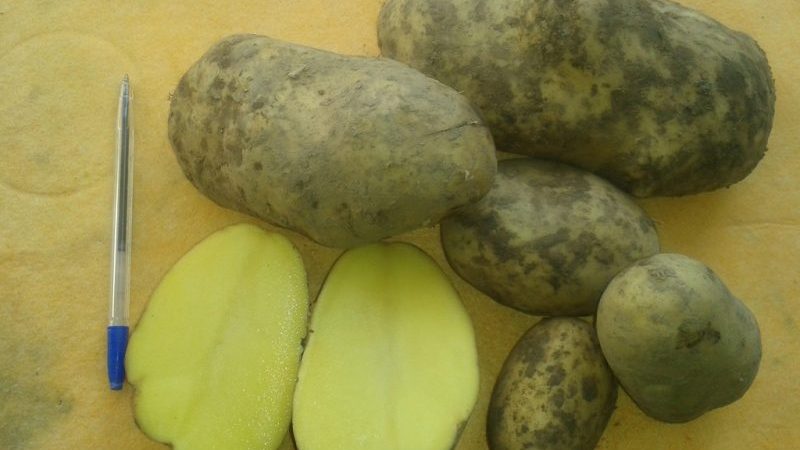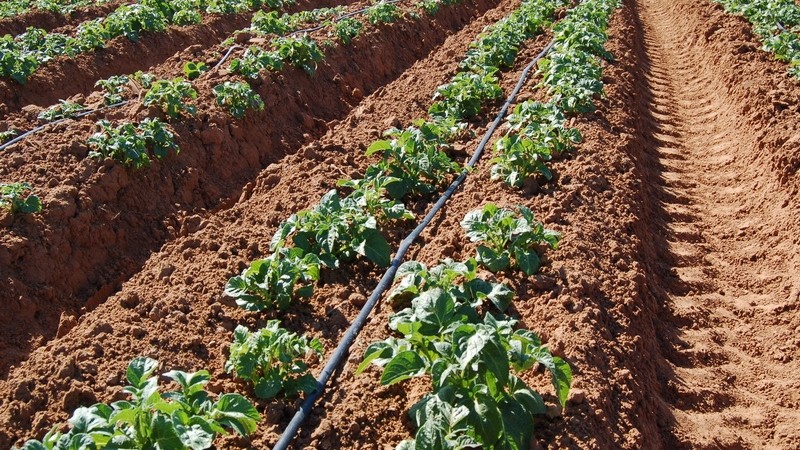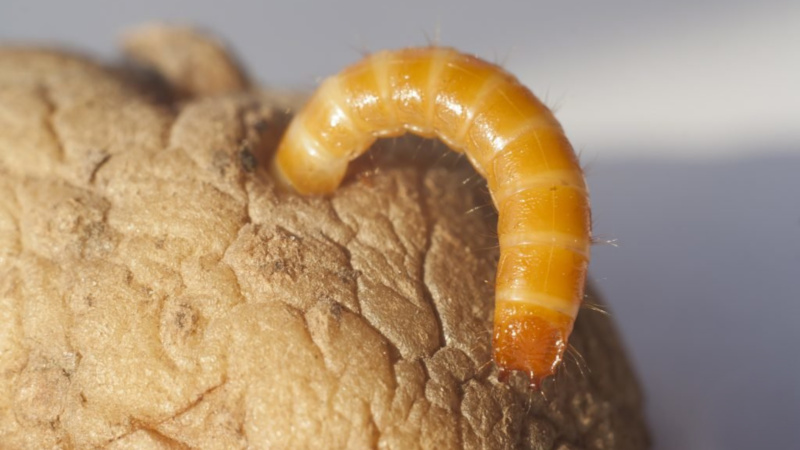Unpretentious to weather conditions, mid-season potato variety "Ramos"
Ramos is a mid-season potato variety officially listed in the state register. It is cultivated on farmlands and summer cottages. With the right approach to cultivation, you can reap a generous harvest.
Below you will find a description of the variety, recommendations for its cultivation, photos and reviews of Ramos potatoes.
The content of the article
Description of the variety
Ramos belongs to the table varieties. Possesses high taste. Proven well in the process cooking - does not boil over, which is why it is suitable for any dishes.
It is often used to make French fries in food service establishments. Ramos is stored for a long time, so the owners of outlets willingly take it for sale.

Origin and development
The Ramos variety was bred by German breeders. Due to its unpretentiousness to external conditions and resistance to many diseases, it began to be cultivated on an industrial scale.
Consumers appreciated the taste of the potato and its popularity began to grow outside Germany. It entered the register of the Russian Federation in 2006.
Chemical composition, trace elements and vitamins
The starch content varies between 13-16%. Also, Ramos potatoes are rich in the following nutrients:
- vitamins A, B, C, E;
- potassium;
- phosphorus;
- calcium.
To get the maximum nutritional value, it is recommended to boil the potatoes in their skins.
Ripening period and yield
Tubers are ready for use 70-80 days after germination, young potatoes can be dig after 30-45 days. In regions with cool summers, the interval between shoots and ripening reaches 100-110 days. Two crops can be harvested in the southern regions.
The average yield is 370 centners per hectare, under favorable conditions the figure exceeds 400 centners. In bad years, the yield drops to 200 centners per hectare. 8-13 tubers come out from the bush.
Disease resistance
Ramos is resistant to golden potato nematode and potato crayfish. In general, with proper care, the culture is rarely infected with the exception of late blight.
Characteristics of tubers and description of appearance
The tubers are oblong. The rind is dense, with a slight roughness, rich yellow color. The eyes are small, located slightly in the depression. The cut flesh is yellow. The average weight of a potato is 100-130 g.

Straight bush, tall compared to other varieties. The leaves are dark green, large. During the flowering period, the bushes are dotted with small white flowers that form a corolla.
Growing regions
The Ramos variety is suitable for growing in central Russia. But southern regions are considered ideal for its cultivation, where summer weather lasts 4-5 months.
Advantages and disadvantages of the variety
Ramos potatoes are popular with farmers and gardeners. It is appreciated for its excellent taste, high keeping quality, and unpretentious care.
Variety advantages:
- High yield, the ability to harvest two crops in one season.
- Early maturation.
- Keeping quality 97%.
- Mostly large tubers of a marketable type - 90-98%.
- Resistant to moisture deficit.
- Simple farming techniques.
- Good taste.
The disadvantages of the variety include a high percentage of late blight development. If the disease is not detected in time and measures are not taken, a significant part of the crop will die.
Difference from other varieties
Ramos potatoes are officially entered in the state register and recommended by agronomists for cultivation in the North-West, Central, Central Black Earth, North Caucasus, Middle Volga and Ural regions.
The main difference from other varieties is the ability to get two harvests per season.
Features of planting and growing
When growing potatoes Ramos, the same agricultural techniques are used as for other varieties. It does not require special care, even a novice gardener has a chance to get a high yield.
Preparing for landing
It is recommended to prepare planting material when harvesting. You need to start not from the size of the tubers, but from the bushes. You need to choose the healthiest bushes with bright green tops, untouched by diseases and pests.
It is also advisable to prepare the future site for potatoes in the fall. It is necessary to free it from weeds and tops from harvested crops. Then dig up and add nitrogen-potassium fertilizers.
The planting material is taken out of the storage facility two weeks before the intended planting in the ground. This contributes to the speedy germination... Additionally, treatment with a growth stimulant and a disinfectant is recommended, for example, the powerful Prestige chemical.
Ground requirements
Ramos potatoes are generally not picky about the type of soil. Ideally, fertile chernozems are suitable, but planting in other types of soil is not critical. To increase yields, it is recommended to plant potatoes where legumes or cereals were grown last year. Cabbage and onions are considered good neighbors.
Important! You cannot plant potatoes in the beds where tomatoes and peppers grew last season. Crops are vulnerable to the same diseases. If pathogens remain in the soil, they will go to potatoes, which will lead to the death of the crop.
Timing, scheme and landing rules
The recommended time for planting tubers in the ground is the beginning of May, when the air temperature exceeds + 18 ° C. Soil temperature should not be less than + 10 ... + 13 ° C.
The optimal distance between the holes is 30-35 cm, between the beds - 60 cm. The tubers are buried in the ground by no more than 10 cm. Otherwise, they will germinate for a long time, and as a result they will ripen for a long time.
Reference. The greater the distance between the holes, the larger the tubers will be.
Growing features

A basic understanding of agricultural technology is sufficient for growing. As soon as the shoots have emerged from the ground, you need to start leaving. When the potatoes have faded, it is recommended to cut the flowers. Then the plant will direct all its forces to the growth and development of tubers.
All care consists in irrigation, feeding and pest control. Events are held at certain stages of cultural development.
Watering mode
The Ramos variety does not need regular watering. At the stage of emergence of sprouts, you can water the beds 2-3 times. If May and June were rainy, there is no need for the procedure.
You can determine the moisture deficit by the bottom sheets - if they are dried, watering will not hurt. In especially hot regions, it is worth equipping a drip irrigation system.
Top dressing
Ramos takes root in any soil, but it requires spraying and root feeding.
Fertilization scheme:
- First feeding: Stir 0.5 liters of humus and 15 g of nitrate in 10 liters of water. After watering, add 1 liter under the bush.
- Second feeding: in 10 liters of water stir a glass of wood ash, 15 g of potassium phosphate and superphosphate. Pour 0.5 liters under each bush.
- Spraying is recommended 2-3 weeks before harvest - for 10 liters of water 2 tbsp. tablespoons of superphosphate. Each bush needs 0.5 liters of solution.
The first and second root dressings are carried out until the end of June. After the tubers are already formed, an excess of fertilizers will lead to a decrease in the taste and useful properties of potatoes.
Weeding and hilling
Weeds must be removed at all stages of cultivation. After flowering, only large grass can be pulled out, which prevents the tubers from developing.
Attention! Ramos does not react well to weed control chemicals. It is not recommended to use them after germination.
Hilling is no less important event. The first time it is necessary to huddle the beds after the emergence of sprouts. This is necessary to aerate the soil that has been trampled down during planting. Hilling is carried out several times, but only before the flowering of the potatoes.
Disease and pest control

Despite the resistance of the variety to most diseases, the potato is exposed to pests. In the southern regions, the culture is attacked by aphids, Colorado potato beetle, bear, wireworm, spider mite, cicadas.
For the prevention and control of insects and diseases, you can use drugs:
- Bicol destroys Colorado potato beetle larvae.
- "Killer", "Destroy" - for fighting adult beetles.
- "Taboo" and "Aktara" cope well with wireworms, aphids, and bear.
- "Maxim" destroys the pathogens of scab, fusarium, rhizoctonia. Also used for black and gray rot.
- "Fitosporin-M" - prevention and treatment of late blight.
- "Rubit Discor" is a powerful drug for the treatment of scab, black leg, powdery mildew.
Growing difficulties
In addition to the high risk of late blight infection, the variety has one feature - dependence on temperature. Ramos loves when the air warms up to + 18 ... + 22 ° C. If the temperature drops or does not exceed + 5 ° C, the growth and development of the culture are suspended. There is also a risk of losing crops if it is a rainy summer.
Harvesting and storage

Potatoes are dug out at the moment of technical maturity. In order not to miss the deadline, you need to count the time from the day of landing. Young tubers are ready for human consumption much earlier, usually a month after germination. But you need to collect them in the amount necessary for cooking - they are not stored for a long time.
How and when to collect
7-10 days before harvesting, you need to cut off the tops so that the tubers grow. It is better to dig potatoes on a clear dry day. After harvesting, you need to leave the tubers under a canopy or in the beds so that they dry out.
Attention! Potatoes need to be dug on time, it is not recommended to postpone harvesting even for a week. The variety is vulnerable to late blight, which affects even ripe tubers.
Storage features and keeping quality of the variety
You can store potatoes in a barn, cellar, refrigerator... Under the storage conditions, keeping quality is 97%. The best place is a dry, dark room, where the temperature does not exceed + 4… + 5 ° C. Keeping tubers in a warm place is fraught with wrinkling and early germination.
Tips from experienced gardeners and reviews of the Ramos variety
Agricultural workers value Ramos potatoes for their unpretentiousness. Summer residents grow it for themselves primarily because of its excellent taste and high keeping rate. To grow on the site, it is not necessary to understand all the intricacies of agriculture.
Novice gardeners should heed the advice of experienced farmers:
- Choose a sunny place for planting.
- Ramos does not like excess moisture. It is better to choose dry places on a hill.
- During watering, make sure that water does not fall on the tops. Otherwise, the risk of developing late blight increases.
- It is best to control weeds without using chemicals.
Gardeners are also ready to share their reviews of the variety.
Ivan, Vologda: “Young tubers have an interesting feature - when treated with a growth stimulant, they germinate quickly.If the climatic features of the region allow, you can harvest twice. "
Veronica, Tula: “The variety is really fruitful. An average of 15 tubers came out from the bush, all almost the same size, even, neat. Excellent taste. The potatoes behaved well during the preparation of all the dishes. "
Natalia, Tver:“I tried to grow Ramos in the country. The variety is really unpretentious, it is content with minimal care. There were no problems with diseases during the cultivation process. The tubers have a presentation. Potatoes keep well. "
Conclusion
Ramos is a relatively unpretentious mid-season potato variety. It is successfully cultivated by experienced farmers on an industrial scale and summer residents for their own needs. Ideal for hot, dry areas. But for gardeners from regions with rainy summers it is better to choose another variety - Ramos does not tolerate excess moisture.